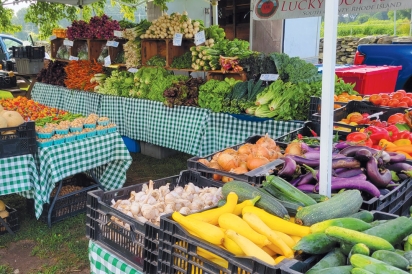Luckyfoot Ranch in Saunderstown
Moving Boulders and Building Soil Pay Dividends in Healthy Produce for a New England Farmer
The name Luckyfoot Ranch evokes a notion of whimsy, and perhaps for good reason. Owner of Luckyfoot Ranch Matt Thibodeau could be described as “the accidental farmer.” Growing up, he saw his grandfather and father till land and grow fresh food, but he never had much interest in the work—at least at that time.
“In addition to a good-sized vegetable garden, my dad kept a dozen Hereford cows and hundreds of New Zealand rabbits,” says as a hobby became a full-time lifestyle and business. “I was just growing stuff and selling some of it. I never really thought much beyond that [back then],” recalls Matt.
In 2009, Matt decided to get more serious. While he began by using land on his family’s property in Charlestown and East Greenwich, in 2011 he took the deeper dive and leased six acres on Gilbert Stuart Road in Saunderstown. “You wouldn’t believe what this place looked like,” says Matt. “It was a mess!” The hard work and dedication that some impressive boulders. “There are a couple of boulders in there that are the size of a car,” says Matt, pointing to the long stretch of rocks. The pile is massive and contains rocks of all sizes; it runs most of the length of the farm. They were unearthed on two occasions when Matt was able to bring in an excavator large enough to do the job. The rocks were buried in the soil, which made farming difficult.
Matt. Each week, Matt’s father would take around 200 rabbits up to Federal Hill in Providence for processing. The meat went out to stores and restaurants. “It’s how we got the name,” says Matt. “But it’s a farm—not a ranch,” he jokes, in a nod to the rabbits.
As something to do, with an eye towards making a bit of extra money when fresh out of high school, Matt started growing vegetables at home and selling them at a local farmers market. As with so many entrepreneurial businesses, what started out mostly took place in the ensuing years has resulted in nothing short of a complete transformation. And, in a move that solidified the future for this Rhode Island farmer, in 2022 Matt was able to purchase the land he had been leasing. By selling the development rights and seeking out grants, he has been able to slowly, but steadily, improve all aspects of the farm.
Now, when people enter the farm, one of the first things they see is a huge pile of rocks (think harbor jetty size), including “That whole pile is available to anyone who wants it,” he implores. “It’s taking up valuable space.”
The six-acre farm has a gentle pitch, and the soil underfoot was low quality before Matt arrived. “There were and still are some drainage issues,” says Matt. The creation and addition of compost has made a palpable difference. The still-visible patches of native soil stand out, pale in stark contrast to the carefully amended dark, nutrient-rich soil that Matt has strived to achieve. Careful use of cover crops during the off season, soil testing and patience have paid dividends.
“In the beginning, we were doing mostly traditional farming—tilling the soil and planting. We had maybe 15 permanent beds. By this spring, that number will be closer to 300,” says Matt. The term “permanent beds” refers to beds that are not turned over by plows but rather continuously built with layers of fresh compost. It is very labor intensive since it means that all planting, weeding and harvesting must be done by hand—but it is better for the soil, and creates a more flavorful and nutritious end result with the wide array of vegetables he grows.
“Trial and error is a slow but effective teacher,” replies Matt when asked how he learned to do myriad jobs necessary to run a successful farm. “Other farmers in the area have been very helpful, too,” he adds. Everything from building growing spaces to operating heavy equipment to managing a team, sales, emails and more are a part of daily life.
That Matt “loves to build things” is evident in the number of caterpillar and high tunnels spread across the farm. “We will be up to six high tunnels before summer,” he says. Every- thing has a name. When entering the farm, the field on the right is called “Left Field.” The greenhouse spaces have names like “Uptown,” “Downtown” and “Midtown.”
“We try to make it fun,” says Matt of the farm and the hard work. The six-member team at Luckyfoot Ranch is all female except Matt and Jerry Lee Lewis, the cat. He says, “It is nothing intentional, it is just how it has worked out. My team is phenomenal and happens to be all female.”
In 2021, a permanent farm stand was added. A small porch out front gives it a rustic feel; the inside space features glass-front refrigerator cases filled with produce and there’s an honor system for payment. Open from 10 am until dusk from May through mid-January, the stand is a convenient way for folks to acquire fresh food at their convenience. In addition, Matt attends weekend farmers markets and there is a weekly community-supported agriculture (CSA) subscription program.
“The CSA is great because it helps with cash flow,” says Matt. CSA members pay in advance for the season’s harvest, which provides much-needed funds to buy seeds, fertilizer, extra compost and other goods needed before the start of the growing season. Crop planning, projections and land management are time consuming and critical wintertime activities.
Says the farmer, “It isn’t an easy lifestyle, and you won’t get rich; it’s challenging—but it’s also very satisfying.”
For more information on the farm CSA, farmers markets and farm stand, visit LuckyfootRanch.com.







